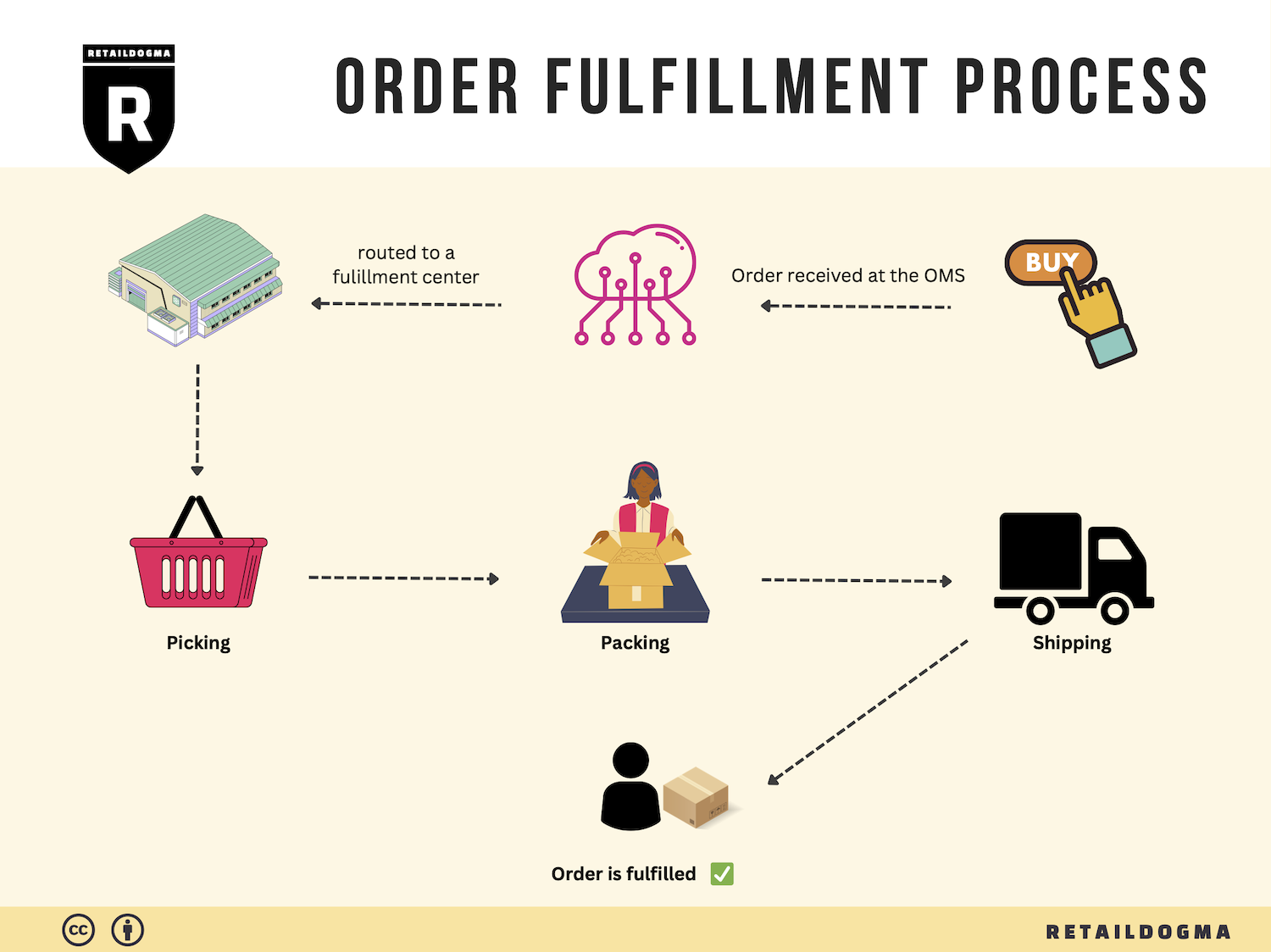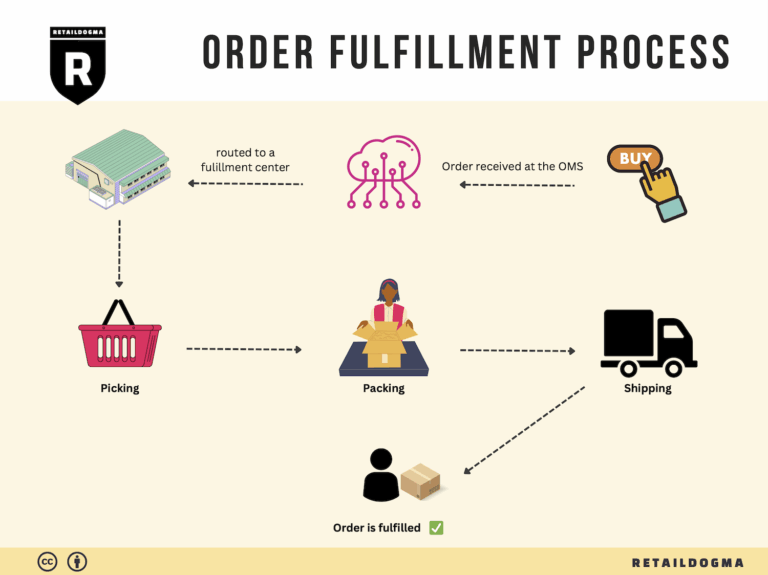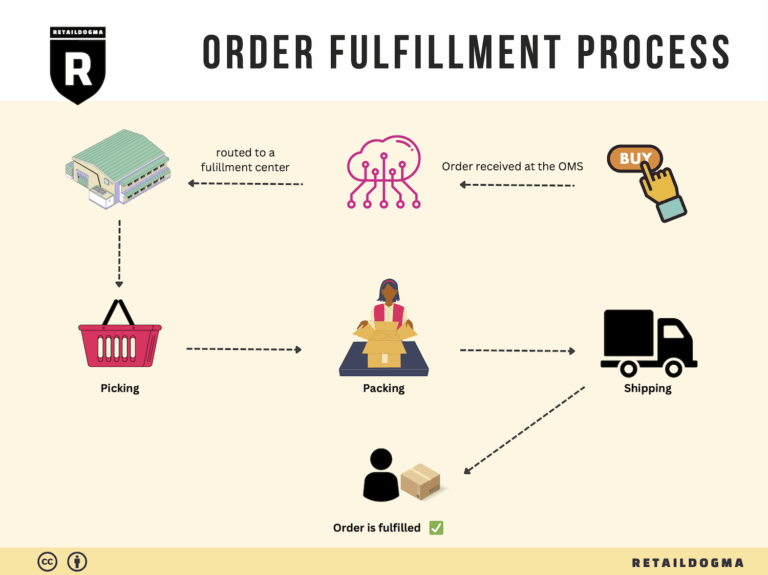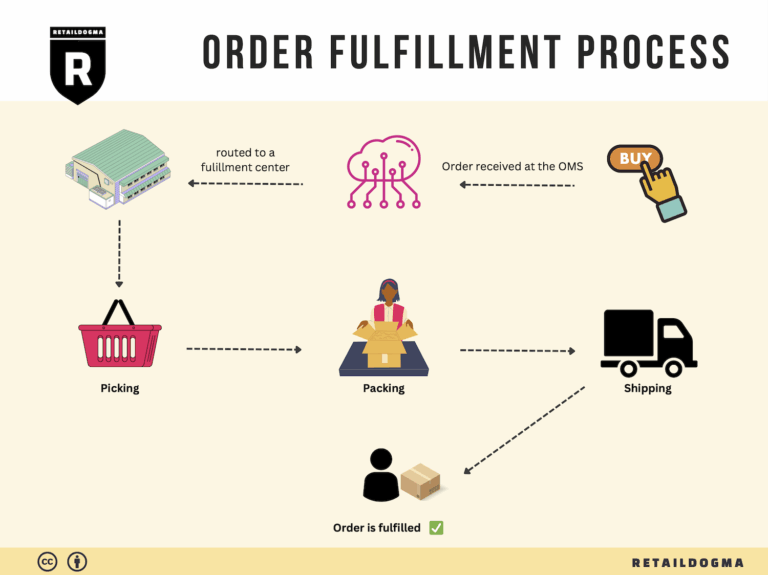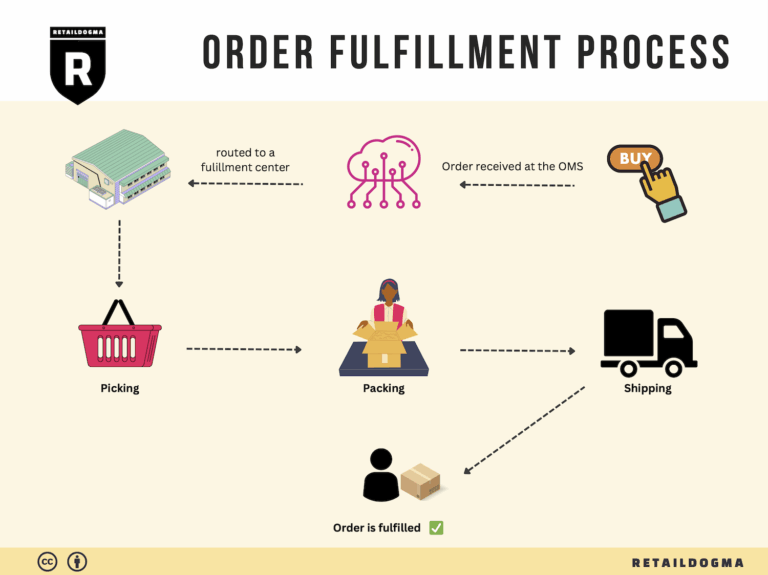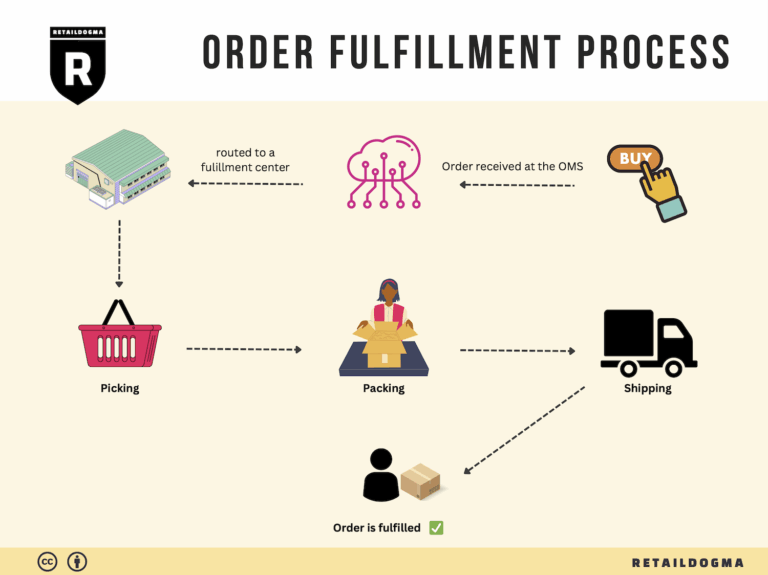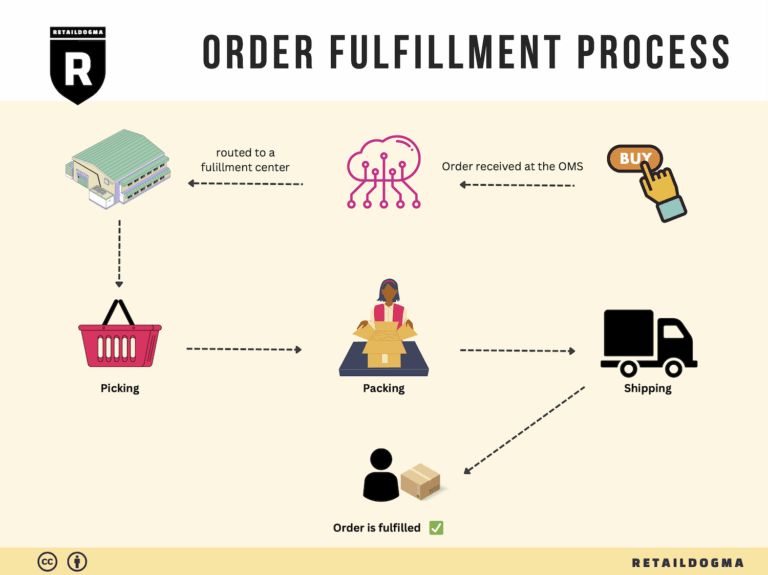What Is A Fulfillment Center? A Complete Guide (2025)
What is E-commerce Fulfillment? An Introduction for Growing Businesses
Understanding the Fulfillment Challenge in E-commerce
As an e-commerce business owner, you’re likely familiar with the overwhelming task of packing and shipping orders. What starts as a simple process can quickly escalate into a logistical nightmare, especially during peak sales periods. Managing inventory, ensuring timely deliveries, and maintaining customer satisfaction can consume valuable time and resources, diverting your focus from growth and innovation. This is where understanding and implementing an efficient fulfillment strategy becomes crucial.
At its core, fulfillment is the process of getting a product from your warehouse to your customer’s doorstep. It encompasses everything from inventory management and order processing to packaging and shipping. As your business scales, the intricacies of fulfillment can become more complex, making it essential to explore various models and strategies to streamline operations.
In this guide, we will delve into the different fulfillment models available to growing businesses, including Third-Party Logistics (3PL) and Fulfilled by Amazon (FBA). Each model has its unique advantages and challenges, and understanding these can help you make informed decisions that align with your business goals.
We will also cover the core services involved in e-commerce fulfillment, such as inventory storage, order processing, and shipping logistics. Understanding these services will enable you to assess what you truly need from a fulfillment partner.
Choosing the right fulfillment partner is a critical decision that can significantly impact your business’s efficiency and customer satisfaction. This guide will provide insights into key factors to consider when selecting a partner, including their technology capabilities, shipping options, and customer service.

Lastly, we will discuss pricing structures associated with different fulfillment models, helping you to evaluate costs and make budget-conscious choices that support your growth trajectory.
The ultimate goal of this guide is to empower you with the knowledge and tools necessary to make smart, strategic decisions about your logistics operations. By optimizing your fulfillment process, you can enhance customer experiences, reduce operational headaches, and focus on scaling your e-commerce business successfully.
What You’ll Learn In This Guide
- What is E-commerce Fulfillment? An Introduction for Growing Businesses
- The Order Fulfillment Process: From ‘Buy’ Button to Customer’s Door
- Comparing Fulfillment Models: In-House vs. 3PL vs. Dropshipping
- A Deep Dive into Amazon FBA: Pros, Cons, and Who It’s For
- Core Services Offered by Fulfillment Centers
- How to Choose a Fulfillment Partner: A 6-Point Checklist
- Understanding Fulfillment Pricing: A Breakdown of Common Fees
- Frequently Asked Questions (FAQs) about Fulfillment
- Conclusion: Is Outsourcing Fulfillment the Right Move for Your Business?
- Important Disclaimer
The Order Fulfillment Process: From ‘Buy’ Button to Customer’s Door
1. Receiving Inventory
The order fulfillment process begins with receiving inventory at the fulfillment center. This is where your products arrive after being shipped from the manufacturer or supplier. Upon arrival, the products undergo a thorough inspection to ensure they match the purchase order in terms of quantity and quality. This step is crucial because accurate receiving prevents stock discrepancies and ensures that the inventory levels in your system reflect the actual stock on hand.
Key Term: SKU (Stock Keeping Unit) – Each product is assigned a unique SKU to facilitate tracking and inventory management. Accurate SKU management during the receiving process ensures that items can be easily located later in the fulfillment process.
2. Warehouse Storage
Once the inventory is received and verified, it is stored in the warehouse. This step involves organizing products in a manner that optimizes space and facilitates easy access for future order picking. Efficient warehouse storage is essential for minimizing the time it takes to fulfill orders, which can significantly impact customer satisfaction.
Products are typically stored based on various criteria, such as size, weight, and demand frequency. High-demand items may be placed closer to the shipping area, while less frequently ordered products can be stored further away. Implementing a systematic storage method, such as ABC analysis, can help prioritize items based on their sales volume, ensuring that your most popular products are easily accessible.
Key Term: FIFO (First In, First Out) – This inventory management method is essential for perishable goods and ensures that older stock is sold before newer stock, reducing waste and ensuring freshness.
3. Order Picking
When a customer places an order, the next step is order picking. This is where warehouse staff retrieve the items from storage to fulfill the order. Efficient order picking is critical, as it directly affects the speed and accuracy of order fulfillment. There are several picking methods, including single order picking, batch picking, and wave picking, each suited for different operational needs.

To streamline the picking process, businesses often utilize pick lists, which are generated based on the orders received. A well-organized pick list allows staff to collect items in a logical sequence, minimizing travel time within the warehouse. Additionally, employing technology such as barcode scanners or mobile picking devices can enhance accuracy and efficiency.
Key Term: Pick Zone – This is a designated area within the warehouse where specific items are stored for easy access during the picking process. Utilizing pick zones can significantly reduce the time taken to gather items for an order.
4. Order Packing
After the items are picked, they move to the packing stage. This step involves securely packaging the products for shipment, ensuring they arrive at the customer’s location in pristine condition. Proper packing not only protects the items during transit but also enhances the unboxing experience for customers, which can positively impact brand perception.
During packing, it’s essential to consider factors such as packaging materials, size, and weight, as these elements can affect shipping costs. Businesses should also include packing slips and any promotional materials to enhance customer engagement. Implementing a packing checklist can ensure that all items are included and correctly packaged before shipment.
Key Term: Dimensional Weight Pricing – This pricing method considers package dimensions along with weight, making it crucial to pack items efficiently to minimize shipping costs.
5. Shipping & Delivery
The final step in the order fulfillment process is shipping and delivery. Once the order is packed, it is handed over to a shipping carrier for delivery to the customer. This stage is vital because it affects the overall customer experience; timely and reliable delivery can lead to higher customer satisfaction and repeat business.
Businesses must choose the right shipping options based on factors such as cost, speed, and reliability. Offering multiple shipping options can enhance customer satisfaction, as customers appreciate flexibility in how they receive their orders. Additionally, providing tracking information allows customers to monitor their order’s progress, further improving their experience.
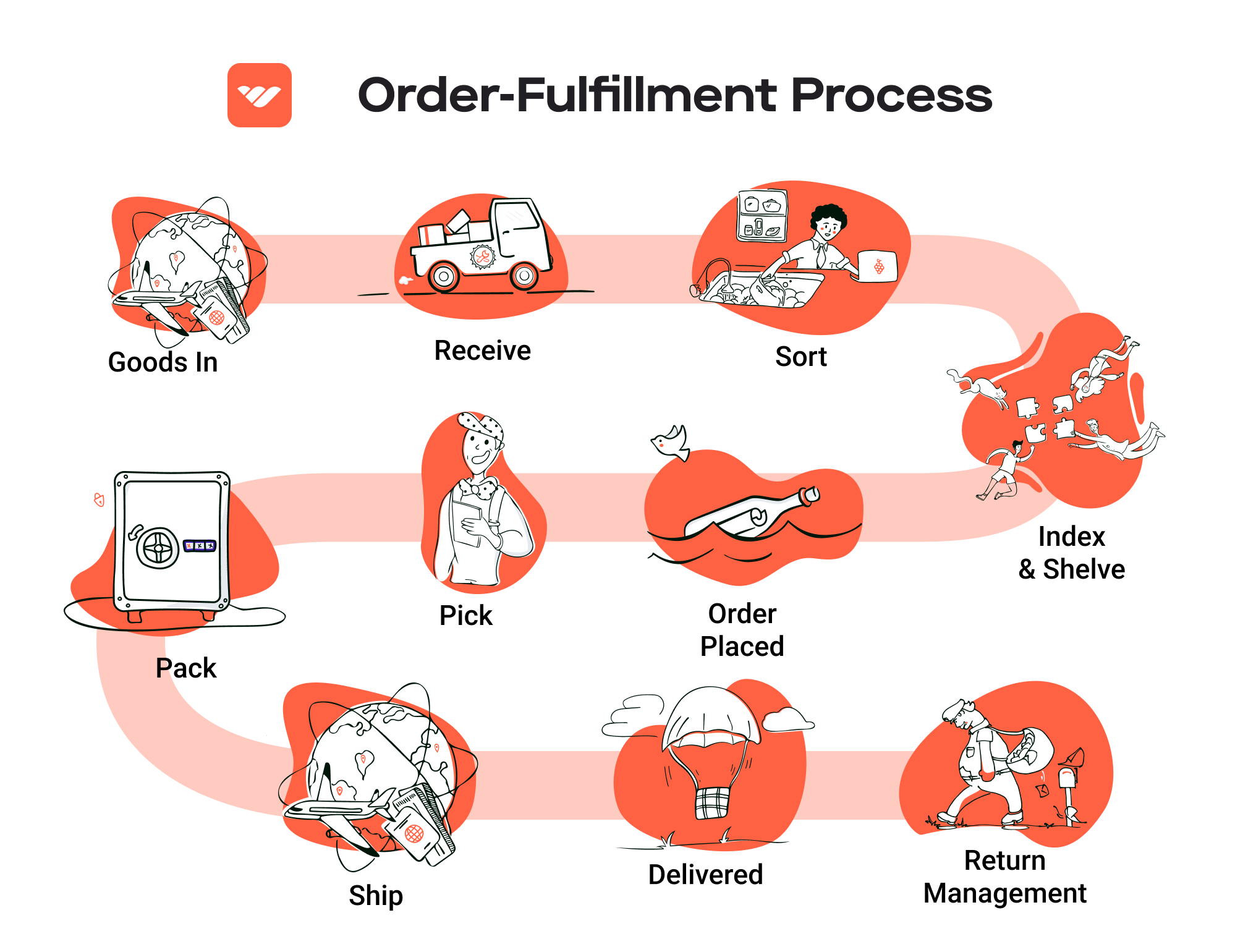
Key Term: Last Mile Delivery – This term refers to the final step in the shipping process, where the package is delivered from the distribution center to the customer’s doorstep. Efficient last-mile delivery strategies are essential for ensuring timely deliveries and minimizing costs.
By understanding and optimizing each of these five steps—receiving inventory, warehouse storage, order picking, order packing, and shipping & delivery—e-commerce businesses can streamline their operations, enhance customer satisfaction, and ultimately scale their logistics effectively.
Comparing Fulfillment Models: In-House vs. 3PL vs. Dropshipping
Fulfillment Model Comparison
| Model | Who Handles Inventory | Best For (Business Stage) | Key Advantage | Key Disadvantage |
|---|---|---|---|---|
| In-House Fulfillment | The business itself | Established businesses | Greater control over inventory and processes | High overhead costs and operational complexity |
| Third-Party Logistics (3PL) | A third-party provider | Growing businesses | Scalability and reduced operational burden | Less control over fulfillment processes |
| Dropshipping | Supplier or manufacturer | Startups and small businesses | Low upfront investment and minimal risk | Lower profit margins and reliance on suppliers |
In-House Fulfillment
In-house fulfillment involves a business managing its own inventory and logistics operations. This model is typically adopted by established businesses that have the resources and infrastructure to handle order processing, warehousing, and shipping. One of the primary advantages of in-house fulfillment is the level of control it offers over inventory management and customer experience. Businesses can tailor their processes, maintain quality standards, and respond quickly to customer demands without relying on external parties. However, the disadvantages include high overhead costs associated with maintaining warehouse space, hiring staff, and investing in technology. Additionally, managing logistics can become operationally complex as order volumes increase, requiring significant management oversight and resources.
Third-Party Logistics (3PL)
Third-party logistics (3PL) providers offer businesses a way to outsource their fulfillment operations. This model is particularly beneficial for growing businesses that want to scale without the burden of managing logistics internally. 3PLs handle inventory storage, order processing, and shipping, allowing businesses to focus on core activities such as marketing and product development. The key advantage of using a 3PL is the scalability it provides; businesses can adjust their logistics needs based on demand without incurring fixed costs associated with in-house operations. However, there are drawbacks, such as reduced control over fulfillment processes and potential challenges in communication and coordination with the 3PL. Businesses must also carefully select a reputable provider to ensure that their customers receive the level of service expected.
Dropshipping
Dropshipping is a fulfillment model where businesses sell products without holding any inventory. Instead, when a customer makes a purchase, the business transfers the order to a supplier or manufacturer, who then ships the product directly to the customer. This model is particularly appealing for startups and small businesses because it requires low upfront investment and minimal risk. Entrepreneurs can test products in the market without the financial burden of inventory costs. However, dropshipping comes with its own set of challenges. Profit margins can be lower due to reliance on supplier pricing, and businesses have less control over product quality and shipping times. Additionally, if a supplier runs out of stock or fails to deliver on time, it can negatively impact customer satisfaction and brand reputation. Therefore, it’s crucial for businesses to establish strong relationships with reliable suppliers.
In summary, each fulfillment model—whether in-house, 3PL, or dropshipping—has its own set of advantages and disadvantages. The choice of model should align with the business’s current stage, resources, and strategic goals. Understanding these differences can help e-commerce businesses effectively scale their operations while meeting customer expectations.
A Deep Dive into Amazon FBA: Pros, Cons, and Who It’s For
Understanding Fulfillment by Amazon (FBA)
Fulfillment by Amazon (FBA) is a service offered by Amazon that allows e-commerce businesses to store their products in Amazon’s fulfillment centers. Amazon takes care of storage, packaging, and shipping, allowing sellers to leverage Amazon’s extensive logistics network. By utilizing FBA, sellers can offer their products with the trusted Amazon Prime badge, increasing their visibility and sales potential.
How FBA Works
-
Setup: Sellers create an Amazon seller account and enroll in the FBA program. They then prepare their products according to Amazon’s guidelines, which include proper labeling and packaging.
-
Shipping to Amazon: Once the products are ready, sellers ship their inventory to designated Amazon fulfillment centers. Amazon has over 185 fulfillment centers worldwide, strategically located to optimize shipping times and costs.
-
Storage and Inventory Management: Amazon stores the inventory in its warehouses. Sellers can track their inventory levels and performance through the Amazon Seller Central dashboard.
-
Order Fulfillment: When a customer places an order for a product, Amazon picks, packs, and ships the item directly to the customer. This process ensures fast delivery, often within one to two days for Prime members.
-
Customer Service and Returns: Amazon handles customer service inquiries and returns for FBA orders, relieving sellers of these responsibilities.
Pros of Using Amazon FBA
Prime Eligibility
One of the most significant advantages of using FBA is that products become eligible for Amazon Prime. This means that sellers can reach millions of Prime members who prefer to purchase items with fast, free shipping. The Prime badge can significantly boost sales and visibility.
Customer Trust
Amazon is a well-established brand that consumers trust. By using FBA, sellers can benefit from this trust. Products fulfilled by Amazon are often perceived as more reliable, which can lead to higher conversion rates.
Multi-Channel Fulfillment
FBA is not limited to Amazon.com. Sellers can use FBA to fulfill orders from other sales channels, such as their own e-commerce websites or other marketplaces. This flexibility allows businesses to streamline their logistics operations.
Scalability
FBA allows sellers to scale their businesses without worrying about logistics. As demand increases, sellers can send more inventory to Amazon, and the platform will handle the increased volume seamlessly.
Global Reach
With fulfillment centers located worldwide, FBA enables sellers to reach international markets. This global infrastructure allows for faster shipping to customers outside the U.S., enhancing the potential for international sales.
Cons of Using Amazon FBA
High Fees
While FBA can simplify logistics, it comes with various fees, including storage fees for inventory and fulfillment fees based on the size and weight of products. These costs can eat into profit margins, especially for lower-priced items.
Strict Inventory Rules
Amazon has strict guidelines for inventory management, including performance metrics that sellers must maintain. Failure to meet these standards can result in penalties or account suspension. Sellers must stay vigilant about their inventory levels and sales performance.
Commingling Risks
When sellers use FBA, their inventory may be commingled with inventory from other sellers. This can lead to issues, such as receiving returns of damaged or unsellable items that originated from other sellers. This risk can affect the quality and condition of products sold.
Limited Control
By relying on Amazon for fulfillment, sellers give up some control over the customer experience. For instance, packaging and branding are standardized, which may not align with a seller’s brand identity. Additionally, sellers are dependent on Amazon’s policies and procedures, which can change.
Competition
FBA can create an environment of increased competition. With many sellers using the same platform, it can be challenging to stand out. Sellers must invest in marketing and optimization strategies to maintain visibility.
Who is FBA Best For?
Fulfillment by Amazon is best suited for:
-
Small to Medium-Sized Businesses: Companies looking to scale quickly without investing heavily in their logistics infrastructure can benefit from FBA’s resources.
-
E-commerce Startups: New sellers can leverage Amazon’s established customer base and logistics network to gain traction in the marketplace.
-
Brands Seeking Global Reach: Businesses looking to expand internationally can use FBA to tap into global markets efficiently.
-
Sellers with High Inventory Turnover: Companies that have a consistent sales volume can offset FBA fees with higher sales, making the program more cost-effective.
-
Multi-Channel Sellers: Businesses that sell across various platforms can streamline their operations using FBA for order fulfillment, allowing them to focus on sales and marketing.
In conclusion, while Fulfillment by Amazon offers numerous advantages that can help scale a business quickly, it is essential to weigh these benefits against the potential downsides. Understanding the intricacies of FBA and aligning them with your business model is crucial for maximizing success in the e-commerce landscape.
Core Services Offered by Fulfillment Centers
Inventory Management & Warehousing
Inventory management and warehousing are foundational services offered by fulfillment centers. These facilities utilize advanced inventory management systems that track products in real-time, ensuring that businesses maintain optimal stock levels. This service includes receiving, storing, and organizing products in a way that maximizes space and efficiency.
For e-commerce businesses, effective inventory management means fewer stockouts and overstock situations. Fulfillment centers typically employ sophisticated software that integrates with e-commerce platforms, providing business owners with visibility into their stock levels and sales trends. This visibility enables timely reordering and helps avoid the pitfalls of inventory mismanagement. Moreover, centralized warehousing allows businesses to store products closer to major customer bases, reducing shipping times and costs.
The benefits of this service extend beyond mere storage; it ensures that your products are organized and easily accessible for quick order fulfillment. This efficiency can enhance customer satisfaction through faster delivery times, ultimately leading to increased sales and customer loyalty.
Pick and Pack Services
Pick and pack services are a critical component of the fulfillment process. This service involves selecting (picking) the ordered items from inventory and packaging (packing) them for shipment. Fulfillment centers employ trained staff and automated systems to streamline this process, ensuring accuracy and efficiency.
For e-commerce businesses, the pick and pack process is essential for maintaining a smooth order fulfillment operation. Quick and accurate picking can significantly reduce the time it takes to process orders, which is crucial in today’s fast-paced retail environment. When customers place orders, they expect prompt delivery; thus, a well-executed pick and pack service can help fulfill those expectations.
Additionally, fulfillment centers can customize packaging according to brand specifications, helping businesses maintain a cohesive brand image. This service not only saves time and labor costs for e-commerce owners but also enhances the overall customer experience, as well-packaged products reduce the likelihood of damage during transit.
Kitting and Assembly
Kitting and assembly services involve bundling multiple products into a single package or preparing products for sale in a specific configuration. This process is particularly useful for e-commerce businesses that offer product bundles, subscription boxes, or customized orders. Fulfillment centers can assemble these kits according to business specifications, ensuring that products are ready for immediate sale.
The primary benefit of kitting and assembly is the ability to create unique product offerings that can attract more customers. For example, if a business sells a skincare line, they might offer a “starter kit” that includes several complementary products. By leveraging kitting services, businesses can streamline their operations, as fulfillment centers handle the labor-intensive assembly process.
Furthermore, kitting services can reduce overall shipping costs by consolidating multiple items into one package. This not only simplifies logistics but also enhances customer satisfaction, as customers receive a comprehensive solution rather than individual products shipped separately.
Returns Management (Reverse Logistics)
Returns management, or reverse logistics, is an essential service for e-commerce businesses, particularly in a market where customer expectations for hassle-free returns are high. Fulfillment centers manage the entire returns process, from receiving returned items to inspecting and restocking them, ensuring that businesses can handle returns efficiently.
For e-commerce owners, effective returns management can significantly impact customer retention and satisfaction. A streamlined returns process encourages customers to make purchases with confidence, knowing they can easily return items if necessary. Fulfillment centers can also analyze return data to identify patterns or issues with specific products, enabling businesses to make informed decisions about inventory and product offerings.
Moreover, a well-managed returns process can enhance operational efficiency. By handling returns in a centralized location, fulfillment centers can minimize the time and resources spent on processing returns, allowing e-commerce businesses to focus on growth and customer engagement.
In conclusion, partnering with a fulfillment center provides e-commerce businesses with the core services needed to scale operations effectively. From inventory management to returns processing, these services enhance efficiency, reduce costs, and ultimately lead to improved customer satisfaction. By leveraging these capabilities, e-commerce businesses can focus on strategic initiatives and growth while leaving the complexities of logistics to the experts.
How to Choose a Fulfillment Partner: A 6-Point Checklist
Location & Warehouse Network
Importance:
The location of your fulfillment partner’s warehouses is crucial for optimizing shipping times and costs. A well-placed network can significantly reduce transit times to your customers, enhancing their experience and potentially increasing repeat purchases.
Questions to Ask:
1. Where are your warehouses located?
Understand the geographical reach of the fulfillment partner. Are they near major transportation hubs or your customer base?
-
How many warehouses do you operate?
A broader network can provide more flexible shipping options and faster delivery times. -
Do you have warehouses in regions where my sales are concentrated?
This ensures that orders can be fulfilled quickly and cost-effectively.
Technology & Integrations
Importance:
The technology used by a fulfillment partner can streamline operations and improve order accuracy. Integration with your existing systems (e-commerce platforms, inventory management, etc.) is essential for seamless data flow.
Questions to Ask:
1. What fulfillment software do you use?
Assess whether the software is robust and user-friendly, and how it can benefit your operations.
-
Can your system integrate with my e-commerce platform?
This is vital for real-time inventory updates and order processing. -
Do you provide tracking capabilities for orders?
Transparency in order tracking enhances customer satisfaction and reduces inquiries about order status.
Specializations (e.g., cold storage, oversized items)
Importance:
Depending on your product range, you may need a partner with specific capabilities, such as cold storage for perishables or handling oversized items. Choosing a fulfillment partner that specializes in your product type can reduce complications and improve service quality.
Questions to Ask:
1. What types of products do you specialize in?
Ensure they have experience handling products similar to yours.
-
Do you have specialized facilities for certain product types?
For example, if you sell food items, inquire about their capabilities for temperature-controlled storage. -
How do you handle damaged or returned goods?
Understanding their process for returns can highlight their operational efficiency and customer service approach.
Scalability & Capacity
Importance:
As your business grows, your fulfillment needs will likely evolve. A partner that can scale with you will help avoid disruptions in service and allow you to focus on growth.
Questions to Ask:
1. How do you handle peak seasons and increased order volumes?
This will give you insight into their capacity and flexibility.
-
Can you accommodate my projected growth over the next few years?
Discussing your growth plans can help gauge if they can meet future demands. -
What is your process for onboarding new clients or expanding services?
Understanding this can clarify how quickly they can adapt to your changing needs.
Pricing and Contracts
Importance:
Cost structures can vary significantly among fulfillment partners. Understanding the pricing model and contract terms is crucial for budgeting and avoiding unexpected expenses.
Questions to Ask:
1. What is your pricing model?
Clarify if they charge per order, storage space, or any other metrics.
-
Are there any hidden fees?
Inquire about additional charges for services such as returns, packaging, or shipping. -
What are the terms of your contract?
Look for details on contract length, cancellation policies, and any penalties for early termination.
Customer Support & Reviews
Importance:
Reliable customer support is essential for resolving issues quickly and maintaining smooth operations. Additionally, reviews and testimonials can provide insights into the partner’s reputation and service quality.
Questions to Ask:
1. What kind of customer support do you offer?
Understand their support availability (e.g., 24/7, business hours) and the channels you can use (phone, email, chat).
-
Can you provide references or case studies from similar businesses?
This helps validate their capabilities and gives you a clearer picture of their performance. -
How do you handle issues that arise during the fulfillment process?
Their response to challenges can indicate their commitment to service and problem-solving.
By utilizing this checklist, e-commerce business owners, operations managers, and entrepreneurs can make informed decisions when selecting a fulfillment partner. The right partner will not only support your current needs but also contribute to your long-term growth and success in the competitive e-commerce landscape.
Understanding Fulfillment Pricing: A Breakdown of Common Fees
Initial Setup Fees
Initial setup fees are typically one-time charges incurred when establishing your account with a fulfillment center like Amazon FBA. This fee can include the costs associated with creating your seller account, onboarding, and integrating your e-commerce platform with the fulfillment system.
The calculation of initial setup fees may vary based on the complexity of your business needs and the level of integration required. For example, if you need custom software solutions or additional training for your team, the costs can escalate. On average, expect to budget anywhere from a few hundred to several thousand dollars, depending on your requirements. Always clarify what services are included in the setup fee to avoid unexpected expenses.
Receiving Fees
Receiving fees are charged when your products arrive at the fulfillment center. These fees cover the labor and processes involved in unloading, inspecting, and storing your inventory.
Typically calculated per unit or per pallet, receiving fees can vary based on the size and weight of your products. For instance, smaller items may incur a lower fee compared to larger pallets. On average, receiving fees can range from $0.20 to $1.00 per item, or a flat fee of $10 to $50 per pallet. It’s essential to factor in these costs when determining your overall fulfillment budget, especially if you anticipate high volumes of incoming inventory.
Storage Fees (per pallet/bin)
Storage fees are charged for holding your products in the fulfillment center’s warehouse. These fees are usually assessed monthly and can be based on the space your inventory occupies, measured in pallets or bins.
The calculation for storage fees can vary significantly depending on the fulfillment center’s pricing structure. Commonly, these fees range from $10 to $40 per pallet per month, while smaller items stored in bins may incur a fee of $0.15 to $0.50 per cubic foot. It’s vital to monitor your inventory turnover rates closely; higher storage fees can erode your profit margins, especially for slow-moving products.
Pick & Pack Fees (per item/order)
Pick and pack fees are incurred each time an order is processed. This fee covers the labor involved in selecting the items from inventory and packing them for shipment.
Pick and pack fees are usually calculated per item or per order. For instance, you might see charges ranging from $1.00 to $3.00 per item, or a flat fee of $3.00 to $5.00 per order, regardless of the number of items included. It’s important to understand how these fees can accumulate, particularly for businesses with a high volume of orders or multiple SKUs. Additionally, if you offer customized packaging or special handling, expect additional charges.
Shipping Fees
Shipping fees are one of the most significant costs associated with fulfillment. These fees cover the delivery of your products to customers and can vary based on factors such as weight, dimensions, shipping speed, and destination.
Shipping costs are typically calculated using a tiered pricing model based on weight brackets, with heavier items incurring higher fees. Additionally, if you’re using Amazon’s FBA, you may benefit from their negotiated shipping rates, which can help reduce costs compared to standard shipping rates. On average, shipping fees can range from $5 to $30 per order, depending on the factors mentioned.
Tips for Getting an Accurate Quote
-
Provide Detailed Information: When requesting a quote, be specific about your product types, dimensions, weights, and anticipated order volumes. This will enable fulfillment centers to provide a more accurate estimate.
-
Ask About Hidden Fees: Inquire about any additional fees that may not be included in the initial quote, such as long-term storage fees, returns processing fees, and seasonal charges.
-
Compare Multiple Fulfillment Centers: Don’t settle for the first quote you receive. Compare pricing and services from multiple fulfillment centers to ensure you are getting the best deal.
-
Negotiate: If you have high volumes or long-term contracts, don’t hesitate to negotiate for better rates. Many fulfillment centers are open to customizing their pricing based on your business needs.
-
Calculate Total Cost of Ownership: Instead of focusing solely on per-unit costs, consider the total cost of ownership, which includes all fees associated with fulfillment. This will provide a clearer picture of your overall expenses and help you make informed decisions.
By understanding these common fees and how they are calculated, e-commerce business owners can better manage their fulfillment costs and optimize their operations for growth.
Frequently Asked Questions (FAQs) about Fulfillment
1. What is the DTW1 Amazon Fulfillment Center?
The DTW1 Amazon Fulfillment Center is one of Amazon’s key logistics hubs located in the Detroit area. It is part of Amazon’s extensive network of fulfillment centers designed to streamline the storage, packing, and shipping of products sold on the Amazon platform. This facility helps sellers reach customers quickly, enhancing delivery speeds and operational efficiency.
2. How does the fulfillment process at DTW1 work?
When you use Amazon’s Fulfillment by Amazon (FBA) service, you send your products to the DTW1 center. Once received, Amazon’s team handles inventory management, order processing, and shipping. When a customer places an order, the DTW1 center picks, packs, and ships the items directly to the customer, allowing for quicker delivery times.
3. What’s the difference between a warehouse and a fulfillment center?
A warehouse is primarily used for storage, where goods are kept until they are needed, often for longer periods. In contrast, a fulfillment center is designed specifically for processing and shipping orders quickly. Fulfillment centers focus on efficiency in picking, packing, and shipping, making them essential for e-commerce businesses that require fast turnaround times.
4. What services does the DTW1 fulfillment center offer?
The DTW1 fulfillment center offers a range of services including inventory storage, order picking and packing, shipping, returns processing, and customer service support. These services are tailored to streamline e-commerce operations and enhance customer satisfaction.
5. How much do fulfillment services cost?
Costs for fulfillment services can vary based on several factors, including the size and weight of the products, storage duration, and order volume. Amazon typically charges fees for storage space, order fulfillment, and additional services like labeling or packaging. It’s advisable to consult Amazon’s FBA fee structure for detailed pricing.
6. What is a Third-Party Logistics Provider (3PL)?
A Third-Party Logistics Provider (3PL) is a company that offers logistics services to businesses, including warehousing, fulfillment, and transportation. Unlike Amazon’s FBA, which is integrated into the Amazon ecosystem, a 3PL can provide customized services tailored to various e-commerce platforms and business models.
7. How can I optimize my inventory management with DTW1?
To optimize inventory management at the DTW1 fulfillment center, regularly analyze your sales data and adjust your inventory levels accordingly. Utilize Amazon’s tools for tracking inventory performance, and consider implementing automated reorder alerts to prevent stockouts or overstock situations.
8. What are the benefits of using the DTW1 fulfillment center for my e-commerce business?
Using the DTW1 fulfillment center offers several benefits, including faster shipping times, access to Amazon Prime customers, reduced operational overhead, and scalability. This allows businesses to focus on marketing and product development while leveraging Amazon’s logistics expertise.
9. Can I use DTW1 for seasonal inventory?
Yes, the DTW1 fulfillment center can accommodate seasonal inventory. However, it’s essential to plan ahead to ensure that you have adequate storage and fulfillment capacity during peak seasons. Amazon provides insights and tools to help manage seasonal inventory effectively.
10. How do I get started with FBA at the DTW1 center?
To get started with FBA at the DTW1 center, you need to create an Amazon seller account, enroll in the FBA program, and prepare your products for shipment. Follow Amazon’s guidelines for labeling and packaging, then send your inventory to the DTW1 fulfillment center. Once your products are received, you can begin selling on Amazon.
Conclusion: Is Outsourcing Fulfillment the Right Move for Your Business?
Evaluating the Benefits of Outsourcing Fulfillment
Outsourcing fulfillment can be a game-changer for e-commerce businesses looking to scale. One of the most significant benefits is the time savings it offers. By partnering with a fulfillment service, you can redirect your focus from logistics and inventory management to critical business functions like marketing and product development. This shift enables you to innovate and grow without getting bogged down by the complexities of order fulfillment.
Scalability is another compelling reason to consider outsourcing. As your business grows, so too does the complexity of managing inventory, processing orders, and meeting customer expectations. A reliable fulfillment partner can seamlessly scale operations to accommodate increased demand, whether that means expanding storage space, optimizing shipping routes, or enhancing customer service. This flexibility allows you to respond quickly to market changes without the significant overhead costs associated with expanding your own logistics infrastructure.
Moreover, fulfillment services come equipped with expertise and technology that many businesses may lack. From advanced inventory management systems to efficient shipping logistics, these providers have honed their processes to ensure faster delivery times and lower shipping costs. This expertise can significantly improve your customer satisfaction rates and enhance your brand reputation.
Choosing the Right Partner for Growth
However, selecting the right fulfillment partner is crucial to your success. Not all providers offer the same level of service or capabilities. It’s essential to conduct thorough research and consider factors such as location, technology, and customer support before making a decision.
Call to Action
Now is the time to evaluate your current shipping processes. Are they hindering your growth potential? Take a moment to audit your fulfillment strategy and consider whether outsourcing could be the next logical step for your business. By making an informed choice, you can position your company for sustainable growth and enhanced operational efficiency.
Important Disclaimer
⚠️ Important Disclaimer
The information in this guide is for educational purposes. Fulfillment services, pricing, and platform features change frequently. Always conduct your own due diligence and consult with providers directly before making business decisions.
